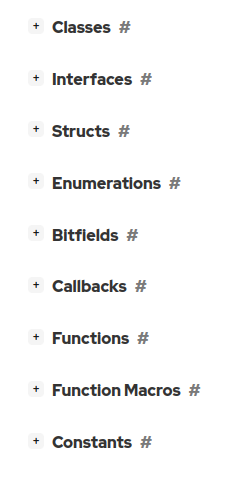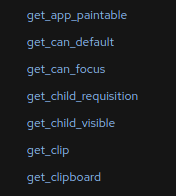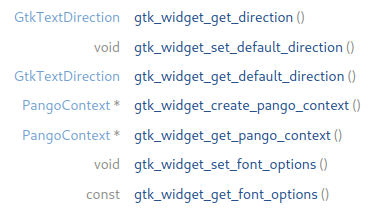It has been quite some time now that the documentation has changed form. Yet I still find myself more comfortable using the old website whenever I can. And when I can’t, like in the documentation of libadwaita, I try to treasure as much as possible from what I read, just for not having to navigate through the website too much.
I will try to make a list here of all the features that for me constitute regressions, hoping to be constructive.
1. Paragraphs are often collapsed
If I visit the main page of the documentation of libadwaita, it is probably because I want to have an overview of the library. But paragraphs are collapsed, which makes the overview impossible unless I click nine times.

2. Things are documented in separate pages
Pages have basically become summaries, because the actual content is documented in separate subpages. This is how the documentation of a function in the new version looks like:
This is how the old version would present the same thing:
This regression is not only for the eye. In the past, if I wanted to see which functions take, for instance, GtkGestureClick * as argument, I could just type Ctrl + F and then GtkGestureClick *, and I would have a fast answer.
3. The table of contents gives no information
The return type of functions has disappeared from the table of content. Now it looks like an anonymous list:

Whereas before it would provide information about data types:

Again, this regression is not only for the eye. In the past, if I wanted to see which functions return, for instance, GtkGestureClick *, I could just type Home to reach the beginning of the page, then Ctrl + F, and then GtkGestureClick *, and I would have a fast answer.
4. Data types are in general gone
Of course I can still find them if I go to the dedicated subpage, but no data types appear in the comprehensive page, again making overviews impossible, unless one memorizes things one by one as I have to do when I deal with libadwaita.
Solutions
I have no reasons to doubt the technical superiority and higher introspective powers of gi-docgen compared to GtkDoc. However after the data is collected and parsed, an HTML document must be generated in the end. And in this particular passage I find GtkDoc still way superior than gi-docgen.
My wish list then goes as follows:
- Never collapse page sections
- I have no idea if someone prefers to have to navigate through subpages all the time instead of finding everything ready simply using the keyboard, but if that is the case, a solution could be to enable gi-docgen to create two outputs, one in which the documentation of a particular module is collected in one single page, and the other one in which the documentation uses subpages. Personally I will not visit this second output.
- Restore data type information in the table of contents
- Restore data type information in figure #2
This is my feedback after quite some experience with both formats, the old and the new one. I hope it will be useful.

